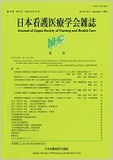Japanese
English
- 有料閲覧
- Abstract 文献概要
- 参考文献 Reference
要 旨
本研究の目的は、健常者の受動的筋弛緩法の体験による主観的評価をPOMS短縮版、リラックス感覚より明らかにすることである。
健常者38名を研究に同意した順に受動的筋弛緩法(PMR)群、能動的筋弛緩法(AMR)群、対照群に振り分け、介入を行った。分析の人数は36名であった。
POMS短縮版は、PMR群とAMR群において、「緊張─不安」「抑うつ─落ち込み」「怒り─敵意」「疲労」「混乱」の5項目は、介入後は有意に減少していた。リラックス感覚は、PMR群では6項目全て「呼吸が落ち着いている」「手や足の指先が温かい」「腕・足の力が抜けている」「顔・首・肩の力が抜けている」「気分が落ち着いている」「心身ともにリラックスしている」が、AMR群では5項目が、介入後の得点が有意に高くなっていた。筋肉に意識を集中させ弛緩していくのみのPMRは、一時的な気分の改善や主観的なリラックスの感覚の上昇をもたらすことが示唆された。
Aim: In the present study, we aimed to examine the subjective assessment of passive muscle relaxation (PMR) in healthy young adults based on the Profile of Mood States (POMS) short form, a relaxation questionnaire.
Methods: Thirty-eight healthy persons who consented to enroll in this study were assigned to the PMR group, active muscle relaxation (AMR) group, or control group according to the order of consent gained. The subjects were asked to complete the Japanese version of the POMS short form and a relaxation questionnaire, before and after the interventions.
Results: Thirty-six subjects were included in the analysis. Significant reductions were observed in the POMS short form scores after intervention in the PMR and AMR groups for the five subscales of tensionanxiety, depression-dejection, anger-hostility, fatigue, and confusion.
All six feelings of relaxation items within the PMR group, “My breathing is calm and steady,” “My fingers and toes feel warm,” “My arms and legs are relaxed,” “My face, neck, and shoulders are relaxed,” “I am feeling calm,” and “I am feeling relaxed both mentally and physically,” and the five items in the AMR group all scored significantly higher post-intervention.
Conclusions: The results suggest that PMR, which only involves focusing on and relaxing the muscles, improves mood and increases the subjective feelings of relaxation, at least temporarily.
Copyright © 2018, Japan Society of Nursing and Health Care All rights reserved.


